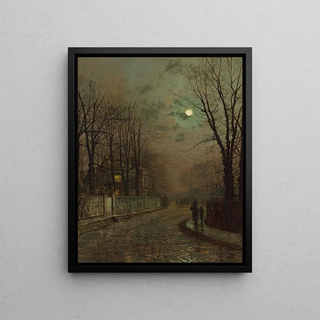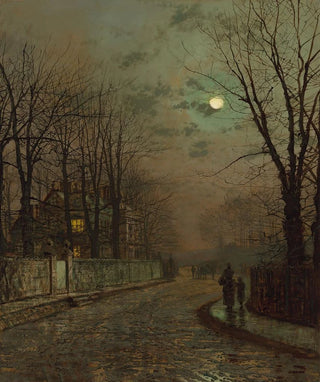Art print | A wet road Knostrop Yorkshire - John Atkinson Grimshaw


View from behind

Frame (optional)
In the fascinating world of art, some works manage to capture the essence of a moment with such intensity that they become timeless. "A Wet Road Knostrop Yorkshire" by John Atkinson Grimshaw is one of these creations. Painted at the end of the 19th century, this piece evokes a mysterious and melancholic atmosphere, where light plays a crucial role. The reflections in the puddles, the winding path, and the glow of the street lamps create an ambiance that is both romantic and nostalgic, transporting the viewer on a visual journey through Yorkshire. This scene, imbued with realism, invites contemplation and daydreaming, revealing the artist's technical mastery while awakening deep emotions.
Style and uniqueness of the work
Grimshaw is distinguished by his skill in playing with light and shadow, an essential characteristic of his style. In "A Wet Road Knostrop Yorkshire," he uses subtle nuances to create striking contrasts. The nighttime scene is enveloped in a light mist, while the street lamps cast a warm glow that illuminates the path. This play of light, combined with meticulous details, such as the trees lining the road and the wet cobblestones, gives the work unparalleled depth and texture. The color palette, rich in blues and golds, enhances the almost dreamlike atmosphere of the composition. Grimshaw thus succeeds in capturing a fleeting moment, an ambiance that one could almost touch, transforming a simple street scene into a poetic work.
The artist and his influence
John Atkinson Grimshaw, born in 1836, is often associated with the Pre-Raphaelite movement, although he developed a style that is uniquely his own. His ability to depict urban and rural landscapes with such sensitivity made him an iconic figure of Victorian realism. Influenced by the rapid changes of industrial society, Grimshaw was able to immortalize the beauty of British landscapes while reflecting the challenges of his era. His works, often charged with melancholy, testify to a deep connection with the

Matte finish

View from behind

Frame (optional)
In the fascinating world of art, some works manage to capture the essence of a moment with such intensity that they become timeless. "A Wet Road Knostrop Yorkshire" by John Atkinson Grimshaw is one of these creations. Painted at the end of the 19th century, this piece evokes a mysterious and melancholic atmosphere, where light plays a crucial role. The reflections in the puddles, the winding path, and the glow of the street lamps create an ambiance that is both romantic and nostalgic, transporting the viewer on a visual journey through Yorkshire. This scene, imbued with realism, invites contemplation and daydreaming, revealing the artist's technical mastery while awakening deep emotions.
Style and uniqueness of the work
Grimshaw is distinguished by his skill in playing with light and shadow, an essential characteristic of his style. In "A Wet Road Knostrop Yorkshire," he uses subtle nuances to create striking contrasts. The nighttime scene is enveloped in a light mist, while the street lamps cast a warm glow that illuminates the path. This play of light, combined with meticulous details, such as the trees lining the road and the wet cobblestones, gives the work unparalleled depth and texture. The color palette, rich in blues and golds, enhances the almost dreamlike atmosphere of the composition. Grimshaw thus succeeds in capturing a fleeting moment, an ambiance that one could almost touch, transforming a simple street scene into a poetic work.
The artist and his influence
John Atkinson Grimshaw, born in 1836, is often associated with the Pre-Raphaelite movement, although he developed a style that is uniquely his own. His ability to depict urban and rural landscapes with such sensitivity made him an iconic figure of Victorian realism. Influenced by the rapid changes of industrial society, Grimshaw was able to immortalize the beauty of British landscapes while reflecting the challenges of his era. His works, often charged with melancholy, testify to a deep connection with the






